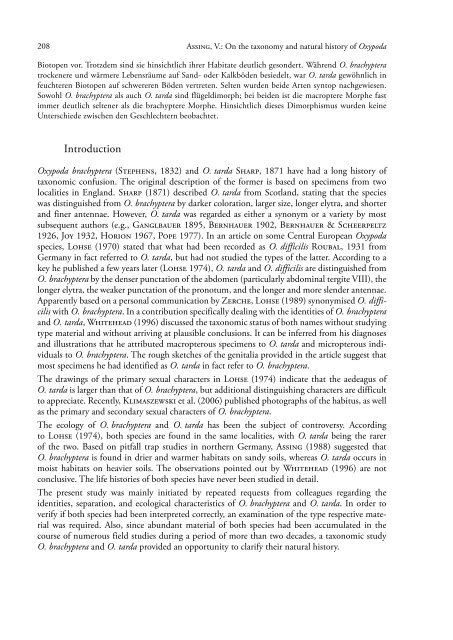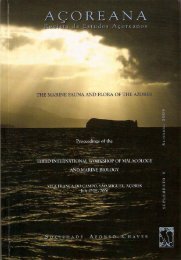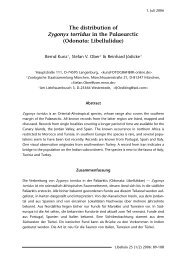On the taxonomy and natural history of Oxypoda brachyptera and O ...
On the taxonomy and natural history of Oxypoda brachyptera and O ...
On the taxonomy and natural history of Oxypoda brachyptera and O ...
Create successful ePaper yourself
Turn your PDF publications into a flip-book with our unique Google optimized e-Paper software.
208 Assing, V.: <strong>On</strong> <strong>the</strong> <strong>taxonomy</strong> <strong>and</strong> <strong>natural</strong> <strong>history</strong> <strong>of</strong> <strong>Oxypoda</strong><br />
Biotopen vor. Trotzdem sind sie hinsichtlich ihrer Habitate deutlich gesondert. Während O. <strong>brachyptera</strong><br />
trockenere und wärmere Lebensräume auf S<strong>and</strong>- oder Kalkböden besiedelt, war O. tarda gewöhnlich in<br />
feuchteren Biotopen auf schwereren Böden vertreten. Selten wurden beide Arten syntop nachgewiesen.<br />
Sowohl O. <strong>brachyptera</strong> als auch O. tarda sind flügeldimorph; bei beiden ist die macroptere Morphe fast<br />
immer deutlich seltener als die brachyptere Morphe. Hinsichtlich dieses Dimorphismus wurden keine<br />
Unterschiede zwischen den Geschlechtern beobachtet.<br />
Introduction<br />
<strong>Oxypoda</strong> <strong>brachyptera</strong> (Stephens, 1832) <strong>and</strong> O. tarda Sharp, 1871 have had a long <strong>history</strong> <strong>of</strong><br />
taxonomic confusion. The original description <strong>of</strong> <strong>the</strong> former is based on specimens from two<br />
localities in Engl<strong>and</strong>. Sharp (1871) described O. tarda from Scotl<strong>and</strong>, stating that <strong>the</strong> species<br />
was distinguished from O. <strong>brachyptera</strong> by darker coloration, larger size, longer elytra, <strong>and</strong> shorter<br />
<strong>and</strong> finer antennae. However, O. tarda was regarded as ei<strong>the</strong>r a synonym or a variety by most<br />
subsequent authors (e.g., Ganglbauer 1895, Bernhauer 1902, Bernhauer & Scheerpeltz<br />
1926, Joy 1932, Horion 1967, Pope 1977). In an article on some Central European <strong>Oxypoda</strong><br />
species, Lohse (1970) stated that what had been recorded as O. difficilis Roubal, 1931 from<br />
Germany in fact referred to O. tarda, but had not studied <strong>the</strong> types <strong>of</strong> <strong>the</strong> latter. According to a<br />
key he published a few years later (Lohse 1974), O. tarda <strong>and</strong> O. difficilis are distinguished from<br />
O. <strong>brachyptera</strong> by <strong>the</strong> denser punctation <strong>of</strong> <strong>the</strong> abdomen (particularly abdominal tergite VIII), <strong>the</strong><br />
longer elytra, <strong>the</strong> weaker punctation <strong>of</strong> <strong>the</strong> pronotum, <strong>and</strong> <strong>the</strong> longer <strong>and</strong> more slender antennae.<br />
Apparently based on a personal communication by Zerche, Lohse (1989) synonymised O. difficilis<br />
with O. <strong>brachyptera</strong>. In a contribution specifically dealing with <strong>the</strong> identities <strong>of</strong> O. <strong>brachyptera</strong><br />
<strong>and</strong> O. tarda, Whitehead (1996) discussed <strong>the</strong> taxonomic status <strong>of</strong> both names without studying<br />
type material <strong>and</strong> without arriving at plausible conclusions. It can be inferred from his diagnoses<br />
<strong>and</strong> illustrations that he attributed macropterous specimens to O. tarda <strong>and</strong> micropterous individuals<br />
to O. <strong>brachyptera</strong>. The rough sketches <strong>of</strong> <strong>the</strong> genitalia provided in <strong>the</strong> article suggest that<br />
most specimens he had identified as O. tarda in fact refer to O. <strong>brachyptera</strong>.<br />
The drawings <strong>of</strong> <strong>the</strong> primary sexual characters in Lohse (1974) indicate that <strong>the</strong> aedeagus <strong>of</strong><br />
O. tarda is larger than that <strong>of</strong> O. <strong>brachyptera</strong>, but additional distinguishing characters are difficult<br />
to appreciate. Recently, Klimaszewski et al. (2006) published photographs <strong>of</strong> <strong>the</strong> habitus, as well<br />
as <strong>the</strong> primary <strong>and</strong> secondary sexual characters <strong>of</strong> O. <strong>brachyptera</strong>.<br />
The ecology <strong>of</strong> O. <strong>brachyptera</strong> <strong>and</strong> O. tarda has been <strong>the</strong> subject <strong>of</strong> controversy. According<br />
to Lohse (1974), both species are found in <strong>the</strong> same localities, with O. tarda being <strong>the</strong> rarer<br />
<strong>of</strong> <strong>the</strong> two. Based on pitfall trap studies in nor<strong>the</strong>rn Germany, Assing (1988) suggested that<br />
O. <strong>brachyptera</strong> is found in drier <strong>and</strong> warmer habitats on s<strong>and</strong>y soils, whereas O. tarda occurs in<br />
moist habitats on heavier soils. The observations pointed out by Whitehead (1996) are not<br />
conclusive. The life histories <strong>of</strong> both species have never been studied in detail.<br />
The present study was mainly initiated by repeated requests from colleagues regarding <strong>the</strong><br />
identities, separation, <strong>and</strong> ecological characteristics <strong>of</strong> O. <strong>brachyptera</strong> <strong>and</strong> O. tarda. In order to<br />
verify if both species had been interpreted correctly, an examination <strong>of</strong> <strong>the</strong> type respective material<br />
was required. Also, since abundant material <strong>of</strong> both species had been accumulated in <strong>the</strong><br />
course <strong>of</strong> numerous field studies during a period <strong>of</strong> more than two decades, a taxonomic study<br />
O. <strong>brachyptera</strong> <strong>and</strong> O. tarda provided an opportunity to clarify <strong>the</strong>ir <strong>natural</strong> <strong>history</strong>.
















